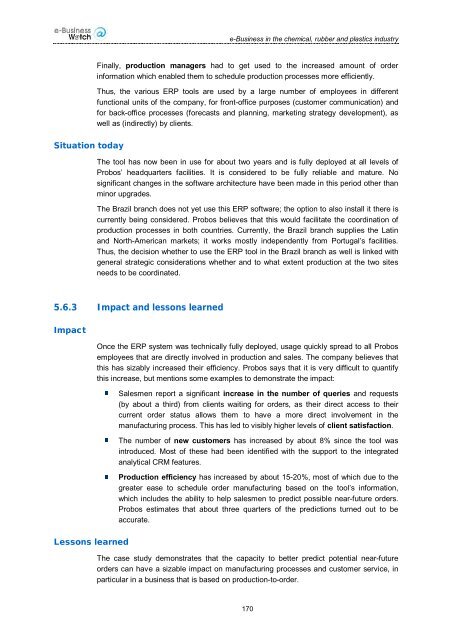Downloads - empirica
Downloads - empirica
Downloads - empirica
Create successful ePaper yourself
Turn your PDF publications into a flip-book with our unique Google optimized e-Paper software.
e-Business in the chemical, rubber and plastics industryFinally, production managers had to get used to the increased amount of orderinformation which enabled them to schedule production processes more efficiently.Thus, the various ERP tools are used by a large number of employees in differentfunctional units of the company, for front-office purposes (customer communication) andfor back-office processes (forecasts and planning, marketing strategy development), aswell as (indirectly) by clients.Situation todayThe tool has now been in use for about two years and is fully deployed at all levels ofProbos’ headquarters facilities. It is considered to be fully reliable and mature. Nosignificant changes in the software architecture have been made in this period other thanminor upgrades.The Brazil branch does not yet use this ERP software; the option to also install it there iscurrently being considered. Probos believes that this would facilitate the coordination ofproduction processes in both countries. Currently, the Brazil branch supplies the Latinand North-American markets; it works mostly independently from Portugal’s facilities.Thus, the decision whether to use the ERP tool in the Brazil branch as well is linked withgeneral strategic considerations whether and to what extent production at the two sitesneeds to be coordinated.5.6.3 Impact and lessons learnedImpactOnce the ERP system was technically fully deployed, usage quickly spread to all Probosemployees that are directly involved in production and sales. The company believes thatthis has sizably increased their efficiency. Probos says that it is very difficult to quantifythis increase, but mentions some examples to demonstrate the impact:Salesmen report a significant increase in the number of queries and requests(by about a third) from clients waiting for orders, as their direct access to theircurrent order status allows them to have a more direct involvement in themanufacturing process. This has led to visibly higher levels of client satisfaction.The number of new customers has increased by about 8% since the tool wasintroduced. Most of these had been identified with the support to the integratedanalytical CRM features.Production efficiency has increased by about 15-20%, most of which due to thegreater ease to schedule order manufacturing based on the tool’s information,which includes the ability to help salesmen to predict possible near-future orders.Probos estimates that about three quarters of the predictions turned out to beaccurate.Lessons learnedThe case study demonstrates that the capacity to better predict potential near-futureorders can have a sizable impact on manufacturing processes and customer service, inparticular in a business that is based on production-to-order.170
















